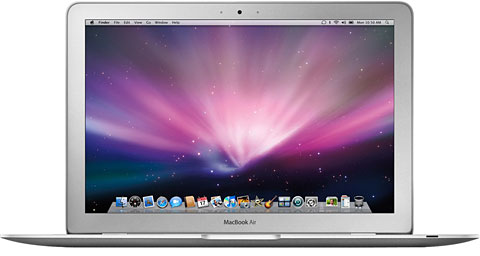When Apple introduced the original MacBook Air in January 2008, 2 GB seemed like plenty of memory. This was the era of Mac OS X 10.5 Leopard, which ran very comfortably with 2 GB – even with graphics eating up 144 MB of system memory. But limited memory was not the MBA’s only problem.
 The worst thing about the MBA has always been that memory is soldered to the system board and cannot be upgraded. If you buy one with 2 GB of RAM, that’s all you’ll ever have. And for the 2008 and 2009 versions, there was not even an option to order the MBA with more system memory.
The worst thing about the MBA has always been that memory is soldered to the system board and cannot be upgraded. If you buy one with 2 GB of RAM, that’s all you’ll ever have. And for the 2008 and 2009 versions, there was not even an option to order the MBA with more system memory.
When OS X 10.6 Snow Leopard arrived in August 2009, 2 GB of system memory was still adequate. But when OS X 10.7 Lion came out in July 2011, 2 GB was barely enough.
Adding insult to injury, the entry-level MacBook Air used a 1.8″ 4200 rpm iPod hard drive on a slow PATA bus, the slowest hard drive Apple ever used on an Intel Mac. On top of that, the 1.6 GHz Core 2 Duo CPU was the least powerful CPU Apple ever used in an Intel-based notebook.
Soldered RAM, a physically tiny hard drive, and a slow CPU helped Apple keep the size, cooling requirements, and cost of the MacBook Air down to $1,799 for the base model. The upgrade model has a 1.8 GHz CPU and a 64 GB Solid State Drive (SSD) with the same 2 GB of RAM, and it retailed at a whopping $3,098!
Performance
Geekbench 3 measures system performance with an emphasis on CPU performance, but results are also impacted by memory, integrated graphics accessing system memory, and drive speed. Here are the 32-bit multicore results for the Early 2008 MacBook Air and the earliest Core 2 Duo MacBook:
- 2.0 GHz Late 2006 MacBook, 1679
- 1.83 GHz Late 2006 MacBook, 1544
- 1.8 GHz MBA with SSD, 1283
- 1.6 GHz MBA with hard drive, 1183
Sure, compared with Atom-based netbooks, the MacBook Air was a powerhouse, but even the $3,100 top-end version lags far behind the consumer MacBook model introduced over a year prior.
Upgrade Options
The best thing to ever happen to original MBA was Other World Computing and others offering upgrade ZIF SSDs in 64 GB and 128 GB capacities, currently selling for $139 and $217.50 respectively. Note that the original MBA uses different drives than later models. (OWC even includes a USB 2.0 case for your original hard drive or SSD to facilitate migrating to the new drive.) An SSD will be a huge performance upgrade for those with the wimpy 1.8″ hard drive – OWC says the SSD is 41x faster!
OWC also offers replacement batteries for 2008-2009 MacBook Airs at just $79 with the same capacity as the original battery.
Conclusion
With only 2 GB of system memory and no option to upgrade that, the Early 2008 MacBook Air is definitely a Road Apple. While 2 GB was adequate, it was not forward looking enough to run OS X Lion well, let alone anything since then. It will run OS X Leopard and Snow Leopard decently, but both of those are supported by less software going forward.
The entry-level model with its 1.6 GHz CPU and 80 GB iPod hard drive is absolutely a Road Apple. If you buy one on the used market, plan on replacing that horrid little hard drive with a 64 GB or 128 GB SSD – and set your purchase price for the MBA accordingly.
The Early 2008 MacBook Air with an SSD installed is a better choice, but still a Road Apple.
Rating
Keywords: #roadapple #early2008macbookair #originalmacbookair
Short link: http://goo.gl/6OnIaE

